
Harishchandra is a legendary king of the Solar dynasty, who appears in several legends in texts such as the Aitareya Brahmana, Mahabharata, the Markandeya Purana, and the Devi Bhagavata Purana. The most famous of these stories is the one mentioned in the Markandeya Purana. According to this legend, Harishchandra gave away his kingdom, sold his family, and agreed to be a slave – all to fulfill a promise he had made to the sage Vishvamitra.

Durga Khote was an Indian actress, beginning as one of the foremost leading ladies of her time. She remained active in Hindi and Marathi cinema, as well as theatre, for over 50 years, starring in around 200 films and numerous theatre productions.
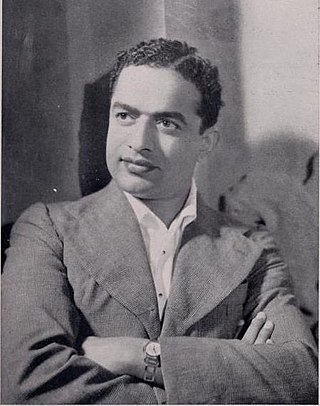
Shantaram Rajaram Vankudre, referred to as V. Shantaram or Shantaram Bapu, was an Indian filmmaker, film producer, and actor known for his work in Hindi and Marathi films. He is most known for films such as Dr. Kotnis Ki Amar Kahani (1946), Amar Bhoopali (1951), Jhanak Jhanak Payal Baaje (1955), Do Aankhen Barah Haath (1957), Navrang (1959), Duniya Na Mane (1937), Pinjara (1972), Chani, Iye Marathiche Nagari and Zunj.

Marathi Cinema, also known as Marathi Chithrapat, is the segment of Indian cinema, dedicated to the production of motion pictures in the Marathi Language widely spoken in the state of Maharashtra. It is based in Mumbai. It is the oldest film industry of India and one of the leader in Filmmaking in India's film industry. The first Marathi talkie film was Ayodhyecha Raja, released in 1932, just one year after Alam Ara the first Hindi talkie, before releasing the Aayodhyecha Raja, all the Marathi films until then were Silent films with Intertitles.
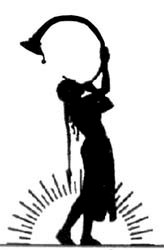
Prabhat Film Company was an Indian film production company and film studios founded in 1929 by the noted film director V.Shantaram and his friends.
Govind Sadashiv Tembe, popularly known as Govindrao Tembe, was a harmonium player, stage actor, and music composer.
Vasant Desai (1912–1975) was an Indian film music composer, most remembered for his score in V. Shantaram films like Jhanak Jhanak Payal Baaje (1955), Do Aankhen Barah Haath (1957), Vijay Bhatt's Goonj Uthi Shehnai (1959), Sampoorna Ramayan (1961), Ashirwad (1968) and Hrishikesh Mukherjee's Guddi (1971).
Maya Macchindra, also titled alternatively as Alakh Niranjan, is the title of various films produced in different languages in India. The story is based on the life of Matsyendranath or Machindranath one of the eighty-four Mahasiddhas, tantric yogic master and the founder of nath lineage, and his famous disciple, baba Gorakhnath.
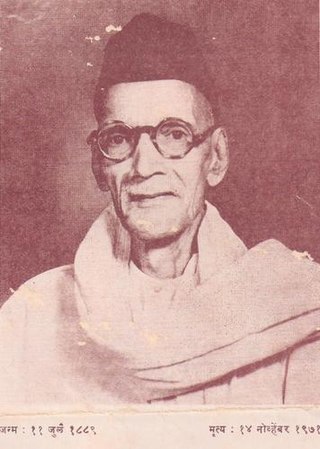
Narayan Hari Apte, popularly known as Nanasaheb Apte was a Marathi popular novelist, writer of advice books and editor from Maharashtra, India.
Vishnupant Govind Damle was an Indian production designer, cinematographer, film director and sound engineer for Marathi films. His 1937 film Sant Tukaram was the first Indian film to be screened at an international film festival. It won a "Special Recommendation" at the 5th Venice International Film Festival.
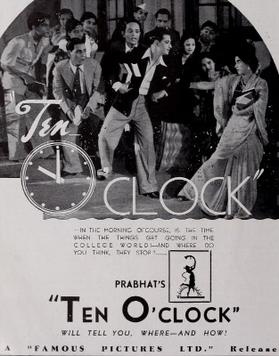
Das Baje, also called 10 O'Clock, is an Indian film. It was released in 1942. This was a debut direction for Raja Nene, a protege of V. Shantaram, and produced under Shantaram's Prabhat Film Company banner. The film was a bilingual, made in Hindi, and in the Marathi language as Daha Wajta. The music direction was by Keshavrao Bhole. The story was written by Kashyap and Pawar, with dialogues in Hindi by Ashant. The photography was by E. Mohammed. It starred Paresh Bannerji, Urmila and Vasant Thengdi in the lead roles, with Baby Shakuntala and Manajirao forming the supporting cast.
Shivaji, was the founder of the Maratha Empire in India. He is considered a prominent historical figure in India. A number of films, books, plays and television serials have been produced about his life and about figures associated with him.
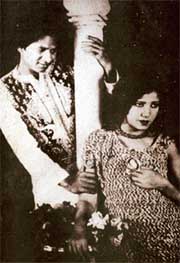
Master Vithal or Vithal (1906-1969) was an actor in Indian cinema, best known as the hero of India's first talkie Alam Ara (1931) and of Marathi and Hindi silent stunt films, which gave him the epithet as the Douglas Fairbanks of India.

Amrit Manthan is a 1934 Indian costume-drama film directed by V. Shantaram for his Prabhat Film Company. The film was produced simultaneously in Hindi and Marathi. The film starred Chandra Mohan, Nalini Tarkhad, Shanta Apte, G. R. Mane, Varde and Kelkar. The film was based on Narayan Hari Apte's novel Bhagyashree. The Hindi translation was done by Veer Mohammed Puri, who also wrote the lyrics for the film.
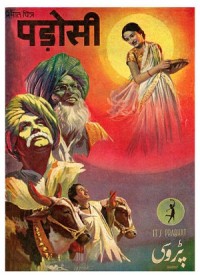
Shejari is also known as Padosi in Hindi version as. Padosi is a 1941 Indian social drama film directed by V. Shantaram. It was produced by Prabhat Film Company and the bilingual film in Marathi and Hindi was the last film Shantaram made for Prabhat before venturing to form his Rajkamal Kalamandir. The film is cited as one of the three social classics Shantaram made at Prabhat. The other two were Duniya Na Mane (1937) and Aadmi (1939). The story and dialogue were by Vishram Bedekar in the Marathi version, while the dialogues in the Hindi version were by Pandit Sudarshan, who also wrote the lyrics. The music director was Master Krishnarao. The famous character artist Radhakrishan made his acting debut in the film as a villain. The film starred Mazhar Khan, Gajanan Jagirdar, Anees Khatoon, Radha Kishan, Lajwanti, Sumitra, Gopal and Balak Ram.

Sinhagad is a 1933 Marathi historical fact film directed by V. Shantaram. The production company was Prabhat Film Company. The story was based on Hari Narayan Apte's literary classic novel "Gad Ala Pan Sinha Gela". Apte was a famous Marathi novelist of the early twentieth century. The story's screenplay and dialogue were written by Narayan Hari Apte. The cinematographers were V. Avadhoot and Keshavrao Dhaiber. The cast included Master Vinayak, Baburao Pendharkar, Keshavrao Dhaiber, Leela Chandragiri, Shinde, Prabhavati, Budasaheb and Shankarrao Bhosle.

Manoos, also called Life's for Living, is a 1939 Indian Marathi social melodrama film directed by V. Shantaram. The movie was simultaneously made in Hindi as Aadmi. The film was based on a short story called "The Police Constable". The story was by A. Bhaskarrao, with screenplay and dialogue by Anant Kanekar. The cinematographer was V. Avadhoot and the music was composed by Master Krishna Rao, with lyrics by Kanekar. The cast included Shahu Modak, Shanta Hublikar, Sundara Bai, Ram Marathe, Narmada, Ganpatrao and Raja Paranjpe.
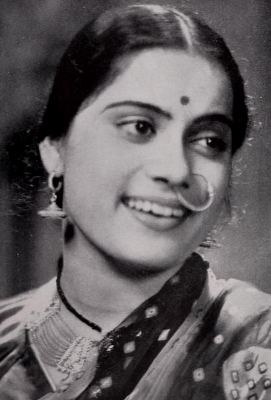
Shanta Apte (1916–1964) was an Indian actress-singer who worked in Marathi and Hindi cinema. Renowned for her roles in films like Duniya Na Mane/Kunku (1937) and Amar Jyoti (1936) under the Prabhat Films banner, she was active in Indian cinema from 1932 to 1958. Apte's impact on Marathi cinema "paralleled" that of Kanan Devi in Bengali cinema. Along with Kanan Devi, Apte is cited as one of the "great singing stars" from before the playback singing era. Apte began her career in films playing the role of a young Radha in the Marathi film Shyamsunder (1932). She joined Prabhat Films acting in her first Hindi language film Amrit Manthan in (1934).
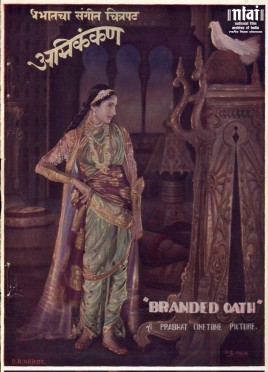
Agnikankan: Branded Oath also called The Branded Oath, is a 1932 Marathi adventure film directed by V. Shantaram. The film was a Prabhat Film Company production and was a bilingual, called Jalti Nishani in Hindi. The cinematography was done by Keshavrao Dhaiber and Art direction by S. Fatehlal. The sound direction was by Vishnupant Govind Damle and the music and lyrics were by Govindrao Tembe. Dialogues for the movie are written by Govindrao Tembe. The character artist Gajanan Jagirdar began his career in films by acting the role of a seventy-five-year-old man at the age of twenty-five. The cast included Shankarrao Bhosle, Kamala Devi, Master Vinayak, Baburao Pendharkar, Nimbalkar and Jagirdar.

Sairandhari (सैरंध्री) a 1933 Indian film based on an episode from the Mahabharata and directed by V. Shantaram. The film was a bilingual made as Sairandhari in both Marathi and Hindi. Produced by Prabhat Film Company, it has been cited as one of the 21 "most wanted missing Indian treasures" by P K. Nair, the National Film Archive of India founder. The music composer was Govindrao Tembe. The cast included Master Vinayak, Leela, Prabhavati, Shakuntala, G.R. Mane, Nimbalkar and Shankarrao Bhosle.















